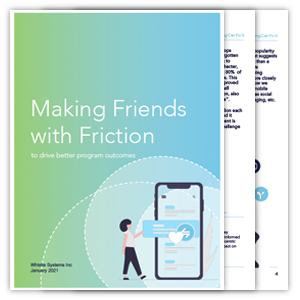Making Friends with Friction
To drive better program outcomes
Positive Friction
It’s an adage that’s championed by software engineers, incentive program designers, business leaders, and behavioral scientists: If you want someone to do something, make it easier for them to do it. Remove barriers. Remove friction. Friction: the anti-business grit slowing down processes, eating profit and costing businesses customers and sales.
Many popular behavioral science models include some mention of the fact that people can only do things if they have the ability to do them, so – all things equal – making the thing easier to do will make people more likely to do it. However, there are several instances where adding some friction has been found to improve user outcomes. We call this “positive friction”.
In this whitepaper, we provide a synthesis of findings around positive friction, and we draw out some general conclusions about the contexts under which some friction can be beneficial. Positive friction, for our purposes, refers to friction that increases the likelihood of the behaviors we want. It can nudge a one-time behavior (such as signing up for a new program) or alter a pattern of behavior (such as checking progress towards a goal).
Sometimes we design with outcomes other than behavior in mind, but the goal is usually to influence behavior. For example, we may want people to enjoy using an app (so they’ll use it more), or we may want people to place more value on a reward (so they’ll work harder to earn it). Any time we add friction purposefully to increase a desired outcome from participants, this is positive friction.
How friction impacts behavior
As a general rule, reducing friction greases the wheels of a desired behavior. When you make a behavior easier to do, people will be more likely to do it. When you make it harder to do, people are less likely to do it either because they don’t have the time or ability, or because they’re not sufficiently motivated to jump through the hoops. Our daily lives are flush with examples where designers have removed friction to nudge our behavior. Subscription services, auto-renewals, and infinite scroll are just a few popular examples. And simplification is a good habit in general. As Nobel Laureate Richard Thaler, co-author of best-selling book, Nudge, explains: “My number-one mantra from Nudge is, ‘Make it easy. When I say make it easy, what I mean is, if you want to get somebody to do something, make it easy. If you want to get people to eat healthier foods, then put healthier foods in the cafeteria, and make them easier to find, and make them taste better.”
Just as reducing friction greases the wheels, adding friction taps the brakes. And while Thaler’s mantra is true much of the time, researchers are increasingly finding that there are some situations where adding friction improves outcomes. It seems counterintuitive that tapping the brakes could lead to greater long-term acceleration towards the desired behavior, but this can be the case. This article will offer some examples of when (and why) adding friction increases vs. decreases the behaviors we want. First, we’ll describe the science behind positive friction: what psychological principles are we leveraging when we use friction to increase a behavior? Next, we’ll present some everyday examples of when removing (vs. adding) friction helps (vs. hurts) behavioral outcomes. We’ll leave you with something of a quick checklist for determining whether you want to lean towards adding or removing friction in a given situation.
Download the full whitepaper to learn more about the science behind positive friction, the Whistle Friction Matrix and how friction impacts behavior.










